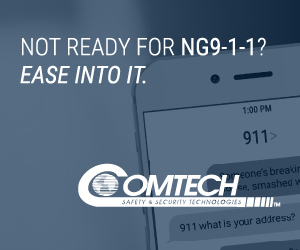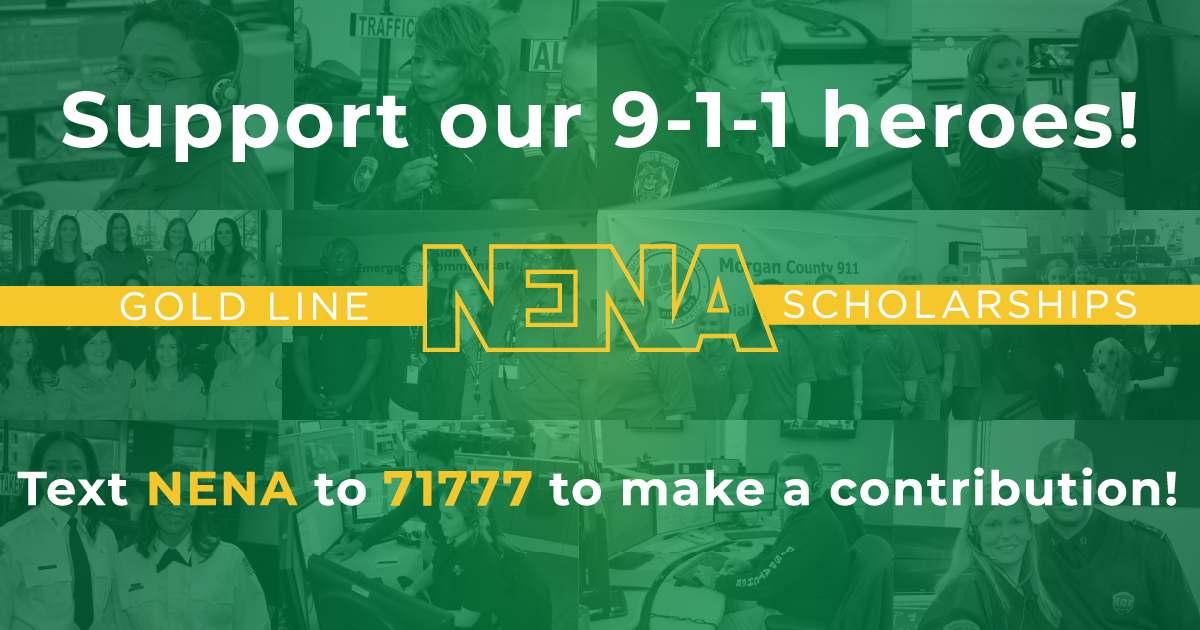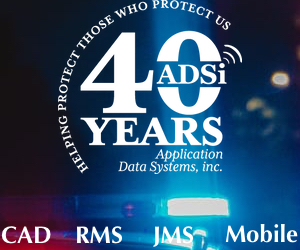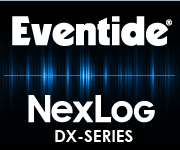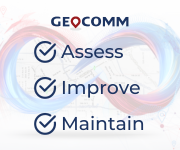 |
||||||||||||||||||
| Archive | Subscribe | Print Friendly | The Call Magazine | www.nena.org | ||||||||||||||||||
 Latest News Latest News
Register now for NENA's NG9-1-1 Standards & Best Practices Conference and the Staffing for Success Critical Issues Forum! Learn, Collaborate, & Contribute at the NG9-1-1 Standards & Best Practices Conference! With your peers from across the 9-1-1 universe, you’ll discuss and work to address the most pressing NG-related issues, including: GIS and NG-data needs; location services and accuracy; interoperability; telecommunicator SOPs; real-time text; transition planning; security and resiliency; multimedia messaging and accessibility; training; stress and wellness; the evolution of 9-1-1 center supervision and management; and more! No other event provides you with the opportunity to shape the future of 9-1-1 and impact public safety for decades to come! Don’t miss your chance to be part of it! Click here to learn more about #NENASBP. Full session details are available here.
Join us on January 20-21 in San Diego, CA as we dive deep into these issues and much more! During this interactive day-and-a-half program, you’ll gain the tools and resources you need to overcome the staffing challenges of today, prepare your center for the future, and make sure your coworkers grow and thrive. Click here to learn more about #NENACIF. Full session details are available here.  9-1-1 Goes to Washington (#NENAGTW) brings you and hundreds of your fellow 9-1-1 professionals together with government leaders in our nation's capital to address today's most pressing 9-1-1 and emergency communications issues. #NENAGTW is the only event where you learn about the policy challenges facing 9-1-1 and then take immediate action to address them through dialogue with your elected and appointed officials. #NENAGTW offers you a significant opportunity to shape the nation’s emergency communications policy agenda. In order to address the needs of today’s 9-1-1 systems while laying the regulatory and legislative groundwork for next-generation systems, you must understand today’s 9-1-1 policy landscape and take an active role in educating policymakers to shape the laws and rules of tomorrow. At #NENAGTW, you will do both. Join us for a dynamic, interactive program where you receive:
Click here to register and here to book your housing.
Join your fellow NENA members for a special virtual happy hour as we kick off 2022! You’ll have the opportunity to expand your professional network and connect with others who share your interests in one of our curated breakout rooms (Women in 9-1-1, Wellness, ENP Certification, LGBTQ+, Diversity & Inclusion, Young Professionals, New to NENA, GIS, Standards Development, and Effective Training & Presenting). No matter what your role or experience level, come meet up for some fun and lively discussions and learn how you can use member benefits like NENA’s mentor center and online communities to invest in yourself, your peers, and our 9-1-1 family. Click here to join on the 12th at 6PM Eastern! NENA, in support of the National 911 Program, has issued a request for information for NG9-1-1/PSBN contract language. No contract language currently exists for entities to include in a procurement to communicate specific interconnection requirements between PSBNs and NG9-1-1 to broadband network providers. The National 911 Program has assembled a group of public and private sector 9-1-1 stakeholders, who have collaborated to facilitate progress toward integration of PSBN and NG9-1-1. The goal of this working group is to develop specific requirements for RFPs/contract language that measures/demonstrates interoperability function(s) and performance. This RFP/contract language will aid states and jurisdictions across the country to understand and effectively communicate their needs to providers who are building ESInets. In order to meet this goal, the working group has compiled an RFI to gather information from the 9-1-1 stakeholder community, related to any language that could or should be included in contracts between NG9-1-1 agencies and PSBN providers. Click here to learn more and respond to the RFI by January 16. NENA’s Next Generation 9-1-1 Industry Collaboration Event (ICE) series provides the opportunity for 9-1-1 equipment and service providers to come together to test products and services in an open, supportive, and collaborative environment. The next ICE, occurring in summer 2022, will be the first event of its kind to include computer aided dispatch (CAD) solutions companies. The event, the tenth in the ICE series, will focus on basic end-to-end emergency call origination, termination, and call / session transfer using the newly-defined i3 version 3 interfaces with an additional focus on the creation, logging, and conveyance of Emergency Incident Data Object (EIDO) through NextGen Core Services and NG PSAP systems (call handling and CAD). In addition to this testing, the National 911 Office is collaborating with NENA during this event coordinating and testing interoperability with EIDO from the PSAP to field responders. Click here to learn more and sign up to participate. Every day, 9-1-1 professionals like you help people facing issues of life and death. So often, a telecommunicator’s calm and reassuring voice is the first sign of hope when all can feel lost. In this new year, you have a chance to help members of our 9-1-1 family. When you contribute to NENA's Gold Line Scholarship Fund, you’re empowering 9-1-1 professionals to do their very best. Time and time again, we've heard that the ability to attend conferences and training programs really makes a difference. Our scholarship recipients receive skills and knowledge that enable them to adapt and overcome the challenges they face every day. But they can't do it without your support! Click here to donate or text NENA to 71777! Our goal for this scholarship drive is $50,000 – enough to provide twenty scholarships for 9-1-1 professionals like you who don’t have access to this vital and life-changing training. It is only through your generosity that we can meet this goal and make an impact!
 Training Update Training UpdateInternational Lessons-Learned From the Pandemic The pandemic brought so many new challenges to PSAPs – not only across the US, but also around the globe. No matter the geographical location, emergency-communications personnel had to rise to the occasion and continue to answer the calls. The challenges faced provided substantial opportunities for learning and innovation; how could we adapt to the new landscape while continuing to provide a high level of service and taking care of our people? Attend this webinar as emergency-services leaders from across the world discuss these issues and more! You’ll hear about how policies and procedures were updated, ways new technologies enabled advancements like remote call-taking, and issues that you need to be thinking about now to future-proof for the "new normal." Can't attend on the 6th? Register now and you will receive an email after the live presentation with instructions for accessing the on-demand webinar archive. Presenters: Jennifer White, ENP - NENA | Monica Million, ENP - Amazon Web Services | John Anthony - British APCO | Ron Willicroft - APCO Canada CEUs: Attend this webinar and receive one-half ENP re-certification point towards the ten-point maximum for NENA courses in the Professional Development CEU/Course Credits section. Webinar Access Info: Dial-in and web-access details provided automatically via email upon registration.  Document Announcements Document AnnouncementsThe Emergency Incident Data Object (EIDO) is the JavaScript Object Notation (JSON) object that contains incident and related information intended to be passed between Functional Elements (FEs) for the stated purpose of processing emergency incidents, such as for use with systems handling 9‑1‑1 calls. EIDO itself constitutes a comprehensive mechanism for passing needed critical information fields between FEs and subsequently incident processing stakeholders. Without an equally reliable method of transport, EIDOs would be left stranded inside proprietary boxes or on disparate islands. It is the purpose of the Standard for the Conveyance of Emergency Incident Data Objects to define a transport model for the secure, verified, and reliable delivery of EIDOs, both during the processing of emergency calls and thereafter. This version of EIDO Conveyance provides for a model of subscribers and notifiers that supports optional settings and filters used to set flow characteristics or limit notifications associated with incidents in which the subscriber is interested. EIDO Conveyance also provides a mechanism for on-demand requests for incident data. Only those edits highlighted in yellow are open for comment during this 2nd review. Members of the Working Group may download the document and submit comments by going here and then selecting "Add a Comment" from the "Edit" icon. All others may download the document and submit comments by going here and then selecting "Add a Comment" from the "Document Actions" icon. Please complete all requested data and click "Save," or, if submitting multiple comments, selecting "Save and Add Another." If submitting a substantial number of substantive comments and/or edits, Commenters may add a single comment in NWS Comment Manager and attach an edited version of the document containing tracked changes. To do this, scroll down to "Add Supporting File" on the comment page and select the file you have edited. If you are providing editorial comments, such as corrections to typos, grammatical errors, style/numbering errors, and incorrect references/links to documents, please document them under one comment and list the page and line number for each. For example:
All comments are due by January 10, 2022. You may contact the NENA Committee Resource Manager with any questions or concerns. The NENA Spoofing Mitigation Information Document describes the application of the Signature-based Handling of Asserted Information Using toKENs (SHAKEN) caller identity spoofing mitigation framework and SIP Resource-Priority Header and Priority header signing/verification procedures to 9‑1‑1 calls and emergency callbacks in an end-state Next Generation 9-1-1 (NG9-1-1) (i.e., all-Internet Protocol [IP]) environment as well as caller identity spoofing mitigation mechanisms applicable to an all-Time Division Multiplexing (TDM) and mixed TDM/IP environment, with a focus on associated operational impacts and considerations. Version 2 of this document considers spoofing mitigation associated with 9-1-1 calls and callback calls in E9‑1‑1 and transitional NG9-1-1 environments. Specifically, Version 2 of this document presents two technically viable options for explicitly conveying attestation level and verification status information to legacy PSAPs via the ALI interface. The amount of space available and the configuration used on Customer Premises Equipment to display call-related information to PSAP call takers varies based the type of equipment deployed. Agencies or 9-1-1 Authorities may place different priorities on the information that is displayed to call takers, making a single solution for providing attestation level and verification status information to PSAP call takers unlikely. An objective of Version 2 of this document is to provide Public Safety with the tools to convey caller authentication information to legacy PSAPs, should a 9-1-1 Authority or Public Safety agency determine it is desirable to do so. Members of the Working Group may download the document and submit comments by going here and then selecting "Add a Comment" from the "Edit" icon. All others may download the document and submit comments by going here and then selecting "Add a Comment" from the "Document Actions" icon. Please complete all requested data and click "Save," or, if submitting multiple comments, selecting "Save and Add Another." If submitting a substantial number of substantive comments and/or edits, Commenters may add a single comment in NWS Comment Manager and attach an edited version of the document containing tracked changes. To do this, scroll down to "Add Supporting File" on the comment page and select the file you have edited. If you are providing editorial comments, such as corrections to typos, grammatical errors, style/numbering errors, and incorrect references/links to documents, please document them under one comment and list the page and line number for each. For example:
All comments are due by January 10, 2022. You may contact the NENA Committee Resource Manager with any questions or concerns. Legacy Selective Router Gateways (LSRGs) will provide the needed functionality to wireline and wireless callers and PSAPs that are served by legacy Selective Routers (SRs) to facilitate emergency call handling during the transition to NG9‑1‑1. The NENA Legacy Selective Router Gateway Standard provides a complete technical standard for the LSRG with examples illustrating its role in the processing of emergency call originations and transfers. Members of the Working Group may download the document and submit comments by going here and then selecting "Add a Comment" from the "Edit" icon. All others may download the document and submit comments by going here and then selecting "Add a Comment" from the "Document Actions" icon. Please complete all requested data and click "Save," or, if submitting multiple comments, selecting "Save and Add Another." If submitting a substantial number of substantive comments and/or edits, Commenters may add a single comment in NWS Comment Manager and attach an edited version of the document containing tracked changes. To do this, scroll down to "Add Supporting File" on the comment page and select the file you have edited. If you are providing editorial comments, such as corrections to typos, grammatical errors, style/numbering errors, and incorrect references/links to documents, please document them under one comment and list the page and line number for each. For example:
All comments are due by January 10, 2022. You may contact the NENA Committee Resource Manager with any questions or concerns.
 The NENA PSAP Master Clock Standard is a guide for designers and manufacturers of PSAP equipment for use in an E9‑1‑1 environment. These specifications are not for use for NG9‑1‑1 time synchronization; those specifications can be found in the Timer Server section of NENA‑STA‑010. This standard identifies engineering and technical requirements to be met before the purchase of such equipment; it may also be of value to purchasers, maintainers, and users of such equipment.
Members of the Working Group can download the document and submit comments by going here and then selecting "Add a Comment" from the "Edit" icon. All others may download the document and submit comments by going here and then selecting "Add a Comment" from the "Document Actions" icon. Please complete all requested data and click "Save," or, if submitting multiple comments, click "Save and Add Another. If submitting a substantial number of substantive comments or edits, you may add a single comment in the Comment Manager and attach an edited version of the document containing your tracked changes. To do this, scroll down and click on "Add Supporting File" on the comment page and upload the file you have edited. If you are providing editorial comments, such as corrections to typos, grammatical errors, style/numbering errors, and incorrect references/links to documents, please document them under one comment and list the page and line number for each. For example:
All comments are due by February 14, 2022. You may contact the NENA Committee Resource Manager with any questions or concerns. The NENA Standard for NG9-1-1 GIS Data Model defines the Geographic Information Systems (GIS) Data Model, which supports the NENA Next Generation 9‑1‑1 (NG9‑1‑1) Core Services (NGCS) of location validation and routing, both geospatial call routing or to the appropriate agency for dispatch. This model also defines several GIS data layers (layers) used in local PSAP and response-agency mapping applications for handling and responding to 9‑1‑1 calls. Members of the Working Group can download the document and submit comments by going here and then selecting "Add a Comment" from the "Edit" icon. All others may download the document and submit comments by going here and then selecting "Add a Comment" from the "Document Actions" icon. Please complete all requested data and click "Save," or, if submitting multiple comments, click "Save and Add Another. If submitting a substantial number of substantive comments or edits, you may add a single comment in the Comment Manager and attach an edited version of the document containing your tracked changes. To do this, scroll down and click on "Add Supporting File" on the comment page and upload the file you have edited. If you are providing editorial comments, such as corrections to typos, grammatical errors, style/numbering errors, and incorrect references/links to documents, please document them under one comment and list the page and line number for each. For example:
All comments are due by February 14, 2022. You may contact the NENA Committee Resource Manager with any questions or concerns.
Having adjudicated all comments, the NENA Standard to Protect the Wellbeing of 9-1-1 Professionals is now considered "stable." Per NENA IPR & Antitrust Policy, Section 4.5.1 a "Stable Form Notice" is being issued and can be viewed here.
 Washington Briefing Washington BriefingPublic safety telecommunicators currently are defined as "Office and Administrative Support occupations" by federal, state, and local classification systems. Due to a lack of objective evidence documenting the current, complete duties of telecommunicators, the U.S. Bureau of Labor Statistics, Standard Occupational Classification System has been unable to reclassify the position. The current classification, which generally covers workers who perform clerical duties, falls far short of providing public safety telecommunicators the recognition they deserve for the work they do. With this in mind, the National 911 Program has developed a four-part toolkit that provides actionable steps to help PSAPs and the public safety community ensure that documentation adequately reflects the current and evolving expectations for public safety telecommunicators. Use of these resources will support data-driven decisions of federal, state, and local agencies and policymakers.
|
||||||||||||||||||
